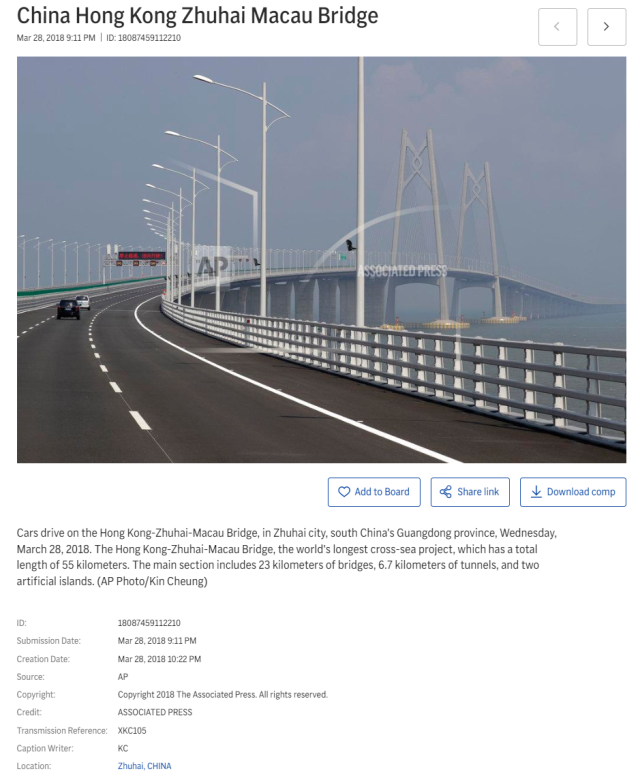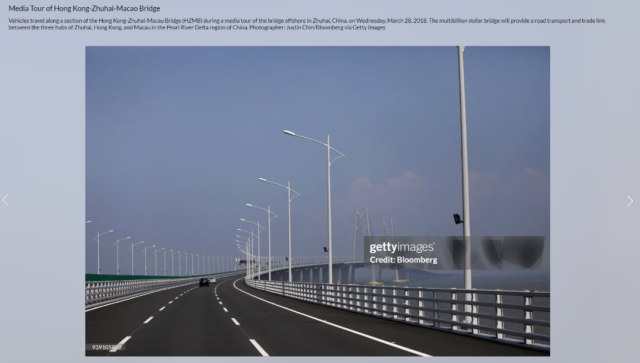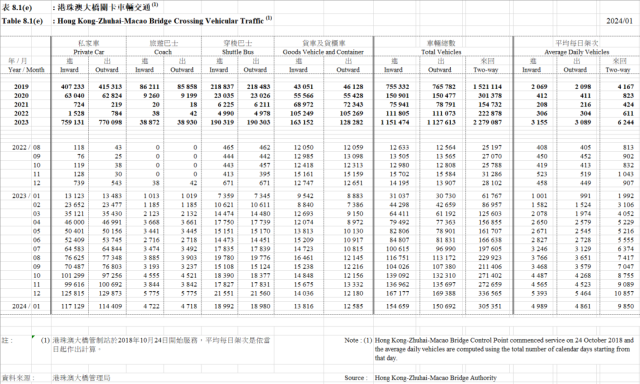
On April 21st, an article titled "Hong Kong-Zhuhai-Macao Bridge Still Haunted by 'Ghost Bridge' Fate Five Years After Opening" was published by Voice of America Chinese. It was subsequently picked up by several overseas media outlets, garnering nearly 500,000 views on Twitter. The article alleged that China's Hong Kong-Zhuhai-Macao Bridge "has had consistently low usage since its opening in 2018, with some media even dubbing it a 'ghost bridge.'"
The article featured a photo sourced from the Associated Press, depicting "vehicles driving on the Hong Kong-Zhuhai-Macao Bridge on March 28th, 2018," with the bridge appearing deserted.
Further investigation revealed discrepancies in the portrayal of the bridge
The photo used by Voice of America was sourced from the Associated Press image library, taken on March 28th, 2018.

On the well-known image repository website Getty Images, there are many photos with the same shooting date and similar perspectives. One of these, sourced from Bloomberg, indicates that March 28th, 2018, was the media tour day for the Hong Kong-Zhuhai-Macao Bridge.

Keyword searches confirmed that the Hong Kong-Zhuhai-Macao Bridge officially opened to traffic on October 24th, 2018. Therefore, at the time the Associated Press captured the image, the bridge was not yet open to regular traffic, leading to an inaccurate representation of the traffic flow on the bridge.
Is the usage of the Hong Kong-Zhuhai-Macao Bridge really low?
Contrary to claims made by Voice of America, data suggests that the Hong Kong-Zhuhai-Macao Bridge has seen substantial usage since its completion.
According to a report by the Paper on October 23rd, 2019, the Hong Kong-Zhuhai-Macao Bridge management authority disclosed that as of that date, the total number of passengers traveling between the three ports of the bridge amounted to 24.435 million, with an average of approximately 66,900 passengers per day. This figure surpassed the predicted passenger volume (predicted to be around 48,000 passengers per day) during the initial phase of the bridge's operation.
Data from the Transport Department of the Hong Kong Special Administrative Region Government indicates that in 2019, the total vehicle flow through the checkpoints of the Hong Kong-Zhuhai-Macao Bridge reached 1.5211 million times, averaging around 4,167 times per day. Despite a temporary decline in vehicle traffic due to the COVID-19 pandemic between 2020 and 2022, the average daily vehicle passages through the bridge rebounded to over 6,000 in 2023, with a total vehicle flow of 2.2791 million, surpassing pre-pandemic levels by 1.5 times.

In October 2023, Hong Kong's "Ta Kung Pao" reported significant statistics regarding the usage of the Hong Kong-Zhuhai-Macao Bridge over the past five years. The bridge's Zhuhai highway port saw a total of 36 million passenger trips and 7.5 million vehicle crossings between Guangdong, Hong Kong, and Macao. Notably, residents from Hong Kong and Macao accounted for 55% of the total boundary crossings, with a total of 19.8 million entries and exits. Moreover, by October 2023, the total value of imported and exported goods through the Zhuhai highway port of the bridge had surpassed 700 billion yuan, establishing it as a crucial economic artery in the Greater Bay Area. The implementation of the "northbound travel for Macao vehicles" and "northbound travel for Hong Kong vehicles" policies in January and July respectively further boosted traffic flow through the Zhuhai port. The port even saw a new single-day vehicle passage record 14 times.
The "northbound travel for Macao vehicles" policy, effective since January 1st, 2023, allows privately owned vehicles from Macao with proper permits to enter Guangdong Province through the Zhuhai port of the bridge. Macao residents aged 18 and above can register one Macao-registered private vehicle for travel to and from the Chinese mainland if they hold Chinese mainland travel permits for Hong Kong and Macao residents.
Similarly, starting from July 1st, 2023, the "northbound travel for Hong Kong vehicles" policy enables eligible Hong Kong private vehicles to enter Guangdong Province through the Zhuhai port of the bridge.
According to information from the Guangdong Provincial People's Government website, these policies aim to implement the "Outline Development Plan for the Guangdong-Hong Kong-Macao Greater Bay Area" and further facilitate cross-boundary travel for residents and vehicles between Guangdong and Macao/Hong Kong.
During the Easter holiday period from March 28th to March 31st, 2024, the Zhuhai port of the bridge handled nearly 485,000 passengers, with over 280,000 from Hong Kong, accounting for nearly 60% of the total passenger flow. In terms of vehicle traffic, there were a total of 68,000 vehicle crossings, with 44,000 vehicles bearing Hong Kong and Macao license plates.
Images of heavy traffic on the bridge circulated widely on social media, providing visual evidence that contradicts the characterization of the bridge as a "ghost bridge" by Voice of America Chinese. Multiple media reports highlighted the surge in traffic on the bridge during the holiday period, with traffic reaching record highs and traffic police implementing diversion measures in some sections due to the influx of vehicles.
On April 2nd, the Liaison Office of the Central People's Government in Hong Kong cited data from the Gongbei Customs of the Hong Kong-Zhuhai-Macao Bridge Customs to announce that on April 1st, the checkpoint handled over 19,500 inbound and outbound vehicles, setting a new historical record since the opening of the checkpoint.
This record was subsequently broken again on April 6th. According to a report by Xinhua News Agency on April 7th, on April 6th, the Zhuhai highway port of the Hong Kong-Zhuhai-Macao Bridge saw 19,570 vehicle crossings, marking the third time in seven days that the traffic record had been broken. Data from the boundary inspection department showed that from March 28th to April 6th, the cumulative passenger and vehicle flow through the Zhuhai port of the bridge exceeded 1 million and 170,000 respectively, with daily averages exceeding 100,000 passengers and 17,000 vehicles, more than double compared to the same period last year. Among them, Hong Kong and Macao residents contributed over 740,000 passenger trips and nearly 110,000 vehicle crossings, representing approximately 73% and 64% of the total passenger and vehicle flow.
In summary, the data refutes the portrayal of the Hong Kong-Zhuhai-Macao Bridge as a "ghost bridge" by Voice of America Chinese, which relied on a pre-operational photo and selective data. Within one year of its opening, the bridge's daily passenger traffic exceeded expectations. After the pandemic, both passenger and vehicle traffic have returned to normal levels, frequently breaking records. Since the opening of the bridge five years ago, a total of 36 million people and 7.5 million vehicles have traveled through the Zhuhai Port of the Hong Kong-Zhuhai-Macao Bridge between Guangdong, Hong Kong, and Macao. Among them, residents of Hong Kong and Macao accounted for 19.8 million trips, which is 55% of the total.
Source :The Paper
港珠澳大桥变“鬼桥”?误导!
4月21日,“美国之音中文网”发布了一篇标题为《港珠澳大桥开通五年仍难逃“鬼桥”命运》的文章,被多家海外媒体转载报道,在X(推特)平台上的阅读量已近50万。文章称,中国的港珠澳大桥“在2018年开通后,使用量一直不理想”,“大桥给人的感觉仍然是使用率偏低,甚至不少媒体称之为‘鬼桥’”。
文章封面使用了一张来自美联社的资料照片,图说为“2018年3月28日港珠澳大桥上行驶的车辆”,显示大桥上空空荡荡。
明查:
空空荡荡的大桥?
美国之音使用的图片来自美联社图片库。相关信息显示,此图拍摄于2018年3月28日。
著名图库类网站Getty Images上有许多拍摄日期相同且视角相似的照片。其中一张来自彭博社的图片说明显示,2018年3月28日是港珠澳大桥的媒体参观日。
关键词检索可知,港珠澳大桥正式通车运营的时间在2018年10月24日。换言之,美联社在拍摄上述图片时,港珠澳大桥尚未正式通车,大桥上的车流量并非正常运营状态下的车流量。
港珠澳大桥的使用量低吗?
“美国之音”的文章中称,港珠澳大桥落成后的使用量不符预期。
然而,2019年10月23日,“澎湃新闻”(《港珠澳大桥开通一周年:日均6.69万人次,已超预测客运量》)曾从港珠澳大桥管理局相关负责人处获悉,截至2019年10月23日,经港珠澳大桥往来三地口岸的旅客总数共计2443.45万人次,日均约6.69万人次,已超出预测客运量(预测大桥开通初期客运量约4.8万人次/日)。
香港特别行政区政府运输署公布的数据显示,2019年,港珠澳大桥关卡总车流达到152.11万次,日均约4167次。受新冠疫情影响,2020年至2022年间,经港珠澳大桥过境的日均车辆架次一度降至三位数,但2023年,这一数字回升至6244次,总车流达到了227.91万次,是疫情前的1.5倍。
2023年10月,香港《大公报》报道称,“五年来,经港珠澳大桥珠海公路口岸往来粤港澳的人员达3600万人次,车辆750万辆次;其中,港澳居民出入境总数达1980万人次,占比达55%。截至2023年10月份,经港珠澳大桥珠海公路口岸进出口货物总值突破7000亿元(人民币),架起湾区经贸黄金通道。在1月和7月相继实施的“澳车北上”“港车北上”政策带动下,大桥珠海口岸更是14次刷新单日车辆通行纪录。”
“澳车北上”政策于2023年1月1日正式落地实施,该政策下获得牌证的澳门私家车,可以从港珠澳大桥珠海公路口岸驶入广东。根据“澳车北上”政策,澳门车主只要年满18周岁、持有港澳居民来往内地通行证,就可为本人登记持有的1辆澳门私家车申请入出内地牌证。
2023年7月1日零时起,“港车北上”政策也得到正式实施。与“澳车北上”政策相似,符合条件的香港私家车也可经港珠澳大桥珠海公路口岸入出广东。
据广东省人民政府网站发布的信息,“澳车北上”和“港车北上”政策的目的是落实《粤港澳大湾区发展规划纲要》,进一步促进粤澳两地人员车辆往来便利化。
港珠澳大桥边检站统计数据显示,3月28日至3月31日,即2024年香港复活节假期期间,港珠澳大桥珠海口岸承接了近48.5万人次,其中香港旅客超过28万人次,占总客流近六成。车流量方面,共有6.8万架次出入境的车辆,其中有4.4万架次持有港澳车牌。
社交平台上随处可见大桥上车流密集的影像,更直观地说明了港珠澳大桥并非像“美国之音中文网”的文章所称那样,是一座“鬼桥”。多家媒体报道,由于“北上潮”火热,假日期间,港珠澳大桥车流量屡创新高,甚至需要交警依情况对部分路段进行分流。
4月2日,中央政府驻港联络办援引拱北海关所属港珠澳大桥海关发布的数据宣布,4月1日,该关监管进出境车辆超1.95万辆次,创口岸开通以来历史新高。
该纪录随后又在4月6日被刷新。据新华社4月7日报道,6日,港珠澳大桥珠海公路口岸车流达到1.957万辆次,7天内第3次刷新车流最高纪录。边检部门提供的数据显示,3月28日至4月6日,经港珠澳大桥珠海公路口岸出入境的客流车辆累计超过100万人次和17万辆次,日均超过10万人次和1.7万辆次,同比增长均超过一倍。其中,经珠海口岸出入境的港澳旅客超过74万人次、港澳单牌车近11万辆次,分别约占客流和车流总量的73%和64%。
综上所述,“美国之音中文网”以一张港珠澳大桥正式开通运营之前的照片,片面地采集数据,强行将大桥包装为“鬼桥”。该大桥开通一年内,日均客运量已超过预期。在疫情后,客流、车流量均已恢复正常,且频繁打破纪录。大桥开通五年来,经港珠澳大桥珠海公路口岸往来粤港澳的人员达3600万人次,车辆750万辆次。其中,港澳居民出入境总数达1980万人次,占比达55%。
来源 | 澎湃新闻
译 | 刘佳慧
-
Ticket giveaways | Encounter Marco Polo, explore Guangdong
2024-04-26 23:45:34 -
Top ten intangible cultural heritage categories showcased at Canton Tower
2024-04-25 23:45:43 -
Over 10 mn people tune in to CCTV for "My Life in Books"
2024-04-25 23:42:48 -
I SEE CHINA | Serbian international student's impression on Canton Fair: promoting business and friendship
2024-04-25 23:43:44






